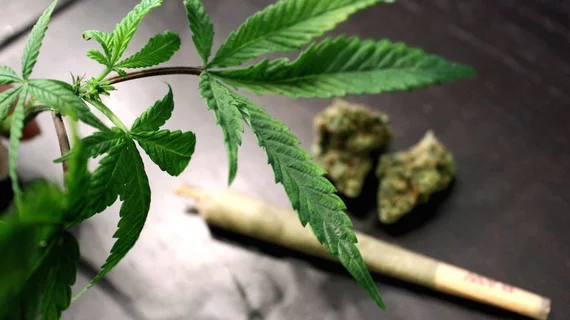About 10 percent of people who suffer a type 1 myocardial infarction (MI) at age 50 or younger use cocaine or marijuana, according to a new study, and these individuals showed double the risk of cardiovascular or all-cause death over extended follow-up.
Cocaine is a known risk factor for MI but the relationship between marijuana and cardiovascular disease is less clear, senior author Ron Blankstein, MD, and colleagues wrote May 28 in the Journal of the American College of Cardiology.
“The recent increase in substance use among young adults and the legalization of marijuana in multiple states have led to a significant public health debate with an urgent need to understand the health effects of this substance use,” they wrote. “Therefore, we sought to determine the prevalence of substance abuse and its association with cardiovascular outcomes in young individuals with their first MI ≤50 years of age.”
Blankstein et al. studied 2,097 patients in that age range from two Boston medical centers—Brigham and Women’s Hospital and Massachusetts General Hospital. They assessed substance use by patient self-reports from the week leading up to the MI or by detection on toxicology screenings.
Among their findings:
- Substance use was identified in 10.7 percent of the patients—6 percent for marijuana and 4.7 percent for cocaine (1.7 percent used both drugs).
- Using either substance was associated with a 2.22-fold risk of cardiovascular mortality over a median 11.3 years of follow-up and a 1.99-fold risk of all-cause mortality. Both of these calculations included adjustments for baseline covariates.
- When compared to non-users, the adjusted hazard ratios for all-cause mortality were 2.09 for marijuana and 1.91 for cocaine. The ratios for cardiovascular mortality were 2.13 for marijuana and 2.32 for cocaine.
- Individuals who used the substances had a lower prevalence of diabetes and high cholesterol but significantly higher tobacco use rates (70.3 percent versus 49.1 percent).
- Out-of-hospital cardiac arrest with the initial MI occurred in 8.8 percent of patients in the marijuana group compared to 3.5 percent of nonusers. There were no significant differences in cardiac arrest between cocaine users and nonusers.
- Mortality rates were 2.34 deaths per 100 person-years in the cocaine group, followed by 1.64 deaths in the marijuana group and 1.11 deaths among those with no evidence of substance use.
“Our findings support the need for aggressive interventions for substance use cessation, as well as aggressive treatment of all other underlying cardiovascular risk factors, among young patients who experience an MI while actively using cocaine or marijuana,” Blankstein et al. wrote. “Importantly, we found an increase in all-cause death among both cocaine and marijuana users. The reason for this finding may be that individuals who use substances may also engage in other high-risk behaviors that can lead to noncardiovascular mortality.”
The researchers said there was a 9 percent average increase in marijuana use each year of the study period (2000-2016), while cocaine use stayed relatively constant.
In a related editorial, three researchers from New York University said there are still plenty of holes in this study and the overall research into marijuana’s relationship to cardiovascular disease.
Alcohol and opioid abuse weren’t assessed in the study, nor were other medical and mental health conditions that could have contributed to mortality. In addition, they pointed out the methods of detecting marijuana users weren’t universally applied so it is likely many users were misclassified as “marijuana-negative,” therefore affecting comparisons between groups.
Also, the changing landscape of cannabis products means older studies of marijuana may be increasingly obsolete. For example, the replacement of inhaled marijuana smoke with edibles, skin oils and cartridges of oil may change the level of harm associated with the substance.
“This study, then, likely does not change the balance of the … conclusion that the evidence of a real cannabis-CVD risk is limited at best,” wrote Joshua D. Lee, MD, MSc, with NYU’s Department of Population Health, and colleagues. “Richer observational data specifically targeting these cannabis-MI questions would be helpful, and interventional trials targeting cannabis reduction and improved heart health may be warranted.”

